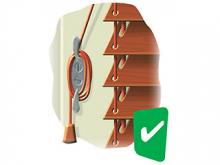The mandatory standard prescribes requirements for the design and construction, performance and safety labelling for folding cots.
This mandatory standard applies to children's portable folding cots that are:
- portable
- used for sleeping and are folded when not in use
- items referred to as playpens that also have a floor.
A playpen with a floor will be substantially similar to a folding cot in terms of the product characteristics and features, where a floor is provided as a supportive base and is an integral component of the product.
The mandatory standard excludes playpens without a floor.
Mandatory standard
Consumer Protection Notice No. 4 of 2008 sets out the requirements for portable and folding cots.
The mandatory standard is based on certain sections of the voluntary Australian New Zealand Standard AS/NZS 2195:1999 Folding Cots – Safety requirements. AS/NZS 2195:1999 is available from SAI Global.
You must consult the mandatory standard for these details.
Key requirements
These requirements aim help to give suppliers a general idea of what is required by the mandatory standard. Suppliers must not rely on this information as a complete guide to compliance.
Testing
While the mandatory standard includes some features you can visually check, it also specifies testing to ensure cots meet requirements for impact, strength, load, durability and stability. It is recommended that suppliers organise product testing through specialist testing laboratories with the right skills, experience and equipment to ensure folding cots comply with the mandatory standard.
Design and construction
Folding cots can either come with a fixed mattress that forms part of the base or a separate mattress that can be removed.
Mattresses, padding and cushioning material
The mattress and all padding and cushioning material must be sufficiently firm to stop them forming to the contours of a child’s face. The base should be designed to provide a firm flat support for a mattress, or should incorporate a mattress.
The mattress must touch the cot on every side and should fit snugly.
Folding cots must not have a mattress or other parts within the cot that are inflatable in their construction. Both manually inflating and self-inflating mattresses are not allowed.
Minimum measurements
While all folding cots have one base sleeping position, some folding cots also come with an additional upper base position designed as a bassinette or change table. To stop children climbing out of the cot, the mandatory standard sets out particular minimum height measurements that apply to:
- the sides or ends of folding cots in relation to the lower cot base and any upper base position
- the position of features that might be used as footholds.
Depth of folding cot lower position
- When no mattress is fitted, the vertical distance from the top of the base to the top edge of the lowest side or end must be a minimum of 550 mm.
- When a mattress is fitted, the vertical distance from the top of the mattress to the top edge of the lowest side or end must be a minimum of 500 mm.
Depth of folding cot upper position
With or without a mattress fitted, the vertical distance from the upper base to the top of the lowest side or end must be a minimum of 250 mm.
Footholds
There must be no features up to 500 mm above the mattress base that present a potential foothold that would allow a child to climb out.
Locking devices
The locking devices that operate the folding mechanism must be designed so that the cot does not collapse inadvertently. All locking devices should:
- have a clearly distinct locked position
- be designed so that a child inside the cot cannot open or activate the mechanism.
Safety and performance
To stop children climbing out of the cot, the mandatory standard sets out specific minimum height measurements that apply to:
- the sides or ends of folding cots in relation to the lower cot base and any upper base position
- the position of features that might be used as footholds.
Safety markings
Folding cots must be permanently, prominently and legibly marked on the inside so that users will see the marking when erecting the cot. The marking must at least include:
- instructions for assembly and locking procedures
- a warning to check before each use that the cot is correctly assembled and that locking devices are fully engaged
- either a warning to only use a mattress of specified dimensions or a warning to only use the mattress supplied with the product—both are allowed
- a warning not to add an extra mattress as this may cause suffocation.




